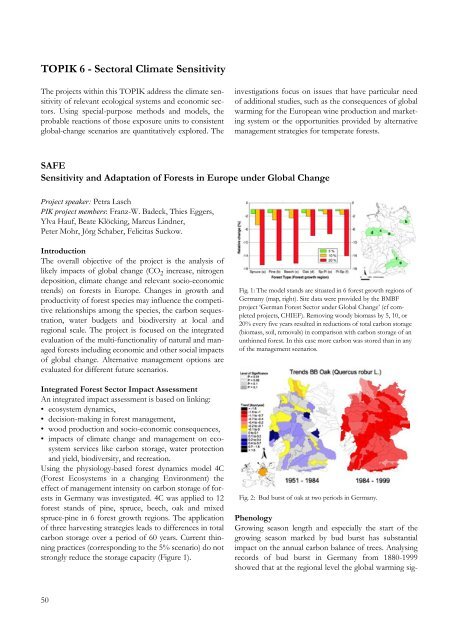PIK Biennial Report 2000-2001 - Potsdam Institute for Climate ...
PIK Biennial Report 2000-2001 - Potsdam Institute for Climate ...
PIK Biennial Report 2000-2001 - Potsdam Institute for Climate ...
You also want an ePaper? Increase the reach of your titles
YUMPU automatically turns print PDFs into web optimized ePapers that Google loves.
TO<strong>PIK</strong> 6 - Sectoral <strong>Climate</strong> Sensitivity<br />
The projects within this TO<strong>PIK</strong> address the climate sensitivity<br />
of relevant ecological systems and economic sectors.<br />
Using special-purpose methods and models, the<br />
probable reactions of those exposure units to consistent<br />
global-change scenarios are quantitatively explored. The<br />
50<br />
investigations focus on issues that have particular need<br />
of additional studies, such as the consequences of global<br />
warming <strong>for</strong> the European wine production and marketing<br />
system or the opportunities provided by alternative<br />
management strategies <strong>for</strong> temperate <strong>for</strong>ests.<br />
SAFE<br />
Sensitivity and Adaptation of Forests in Europe under Global Change<br />
Project speaker: Petra Lasch<br />
<strong>PIK</strong> project members: Franz-W. Badeck, Thies Eggers,<br />
Ylva Hauf, Beate Klöcking, Marcus Lindner,<br />
Peter Mohr, Jörg Schaber, Felicitas Suckow.<br />
Introduction<br />
The overall objective of the project is the analysis of<br />
likely impacts of global change (CO 2 increase, nitrogen<br />
deposition, climate change and relevant socio-economic<br />
trends) on <strong>for</strong>ests in Europe. Changes in growth and<br />
productivity of <strong>for</strong>est species may influence the competitive<br />
relationships among the species, the carbon sequestration,<br />
water budgets and biodiversity at local and<br />
regional scale. The project is focused on the integrated<br />
evaluation of the multi-functionality of natural and managed<br />
<strong>for</strong>ests including economic and other social impacts<br />
of global change. Alternative management options are<br />
evaluated <strong>for</strong> different future scenarios.<br />
Integrated Forest Sector Impact Assessment<br />
An integrated impact assessment is based on linking:<br />
• ecosystem dynamics,<br />
• decision-making in <strong>for</strong>est management,<br />
• wood production and socio-economic consequences,<br />
• impacts of climate change and management on ecosystem<br />
services like carbon storage, water protection<br />
and yield, biodiversity, and recreation.<br />
Using the physiology-based <strong>for</strong>est dynamics model 4C<br />
(Forest Ecosystems in a changing Environment) the<br />
effect of management intensity on carbon storage of <strong>for</strong>ests<br />
in Germany was investigated. 4C was applied to 12<br />
<strong>for</strong>est stands of pine, spruce, beech, oak and mixed<br />
spruce-pine in 6 <strong>for</strong>est growth regions. The application<br />
of three harvesting strategies leads to differences in total<br />
carbon storage over a period of 60 years. Current thinning<br />
practices (corresponding to the 5% scenario) do not<br />
strongly reduce the storage capacity (Figure 1).<br />
Fig. 1: The model stands are situated in 6 <strong>for</strong>est growth regions of<br />
Germany (map, right). Site data were provided by the BMBF<br />
project ‘German Forest Sector under Global Change’ (cf completed<br />
projects, CHIEF). Removing woody biomass by 5, 10, or<br />
20% every five years resulted in reductions of total carbon storage<br />
(biomass, soil, removals) in comparison with carbon storage of an<br />
unthinned <strong>for</strong>est. In this case more carbon was stored than in any<br />
of the management scenarios.<br />
Fig. 2: Bud burst of oak at two periods in Germany.<br />
Phenology<br />
Growing season length and especially the start of the<br />
growing season marked by bud burst has substantial<br />
impact on the annual carbon balance of trees. Analysing<br />
records of bud burst in Germany from 1880-1999<br />
showed that at the regional level the global warming sig-

















